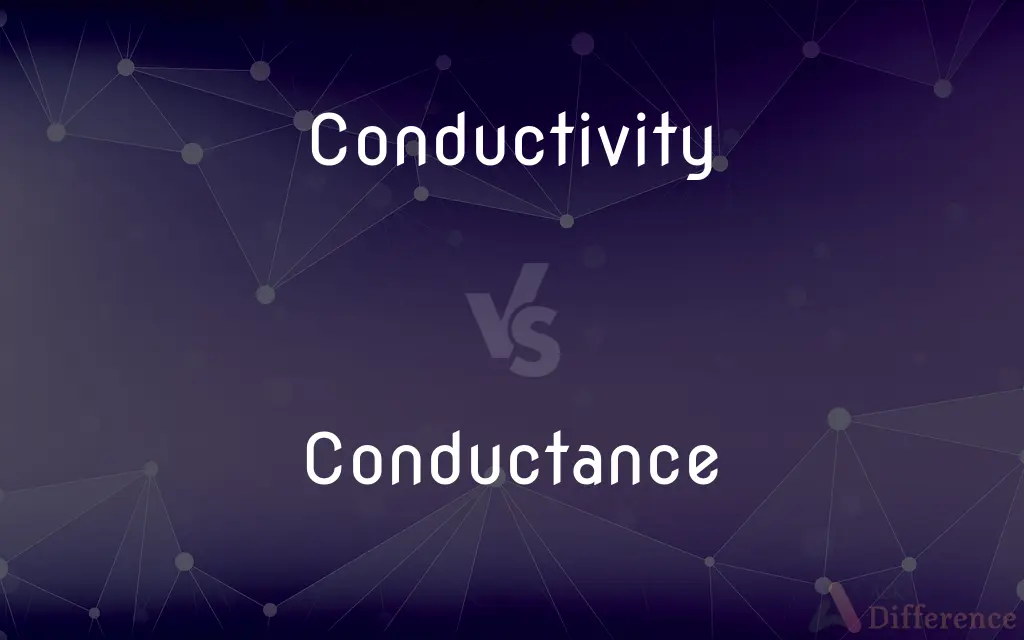Conductivity vs. Conductance — What's the Difference?
Edited by Tayyaba Rehman — By Fiza Rafique — Updated on September 24, 2023
Conductivity is a material property that measures how well it allows the flow of electric current, often in units of S/m. Conductance is the measure of how easily electricity flows through a specific component or circuit, generally in siemens (S).

Difference Between Conductivity and Conductance
Table of Contents
ADVERTISEMENT
Key Differences
Conductivity is a term often used to describe the ability of a material to conduct electric current. This is a property intrinsic to the material itself, irrespective of its size or shape. It is commonly measured in units of Siemens per meter (S/m). Materials with high conductivity include metals like copper and silver.
Conductance, on the other hand, is a measure of how easily electric current flows through a specific electrical component, such as a wire, resistor, or circuit. Unlike conductivity, which is a property of the material, conductance depends on both the material and its dimensions. It is usually measured in Siemens (S).
Both conductivity and conductance are crucial in the realm of electrical engineering and physics. Conductivity often plays a significant role in determining the efficiency of materials used in electrical applications. Conductance is particularly important when evaluating or designing electrical circuits, as it helps to understand how easily current will flow through individual components.
While both terms are related to the flow of electrical current, they are applied in different contexts. Conductivity is a property that remains constant for a specific material under given conditions. Conductance can vary based on the dimensions of the object and the material it's made from.
Comparison Chart
Meaning
Ability of a material to conduct electric current
Ease of electric flow through a component
ADVERTISEMENT
Unit
Siemens per meter (S/m)
Siemens (S)
Dependency
Material only
Material and dimensions
Grammar
Noun
Noun
Context
Material science, physics
Electrical engineering, circuits
Compare with Definitions
Conductivity
A property measuring how well a material conducts electric current.
Copper has high electrical conductivity.
Conductance
Expressed in units of Siemens (S).
The circuit has a total conductance of 10 S.
Conductivity
Expressed in units of Siemens per meter (S/m).
The conductivity of pure water is extremely low.
Conductance
Relevant in circuit design and analysis.
Engineers consider conductance when designing circuits.
Conductivity
Intrinsic to the material itself.
The conductivity of gold is constant regardless of the shape or size of the piece.
Conductance
Dependent on both the material and its dimensions.
The conductance of a wire increases with its length and cross-sectional area.
Conductivity
Independent of the object's dimensions.
Conductivity is solely a property of the material, not its dimensions.
Conductance
A measure of how easily electric current flows through a component.
The conductance of this resistor is 5 Siemens.
Conductivity
Relevant in material selection for electrical applications.
Materials with good conductivity are often used in wiring.
Conductance
Specific to individual electrical components.
Each resistor in a circuit has its own conductance.
Conductivity
The ability or power to conduct or transmit energy (such as heat, electricity, or sound) or a substance (such as electrons or ions).
Conductance
Symbol G A measure of a material's ability to conduct electric charge; the reciprocal of the resistance.
Conductivity
The conductance of a material.
Conductance
Thermal conductance.
Conductivity
(Physiology) The conductibility of a structure, especially the ability of a nerve to transmit a wave of excitation.
Conductance
(physics) A measure of the ability of a body to conduct electricity; the reciprocal of its resistance.
Conductivity
The ability of a material to conduct electricity, heat, fluid or sound
Conductance
Conducting power; - the reciprocal of resistance. A suggested unit is the mho, the reciprocal of the ohm.
Conductance is an attribute of any specified conductor, and refers to its shape, length, and other factors. Conductivity is an attribute of any specified material without direct reference to its shape or other factors.
Conductivity
(physics) The reciprocal of resistivity
Conductance
A material's capacity to conduct electricity; measured as the reciprocal of electrical resistance
Conductivity
The quality or power of conducting, or of receiving and transmitting, as heat, electricity, etc.; as, the conductivity of a nerve.
Conductivity
The transmission of heat or electricity or sound
Common Curiosities
What is conductivity?
Conductivity is a property that measures a material's ability to conduct electric current.
How is conductivity measured?
It's measured in Siemens per meter (S/m).
What is conductance?
Conductance measures how easily electricity flows through a specific component or circuit.
How is conductance measured?
It's measured in Siemens (S).
Where is conductivity commonly used?
In material science and physics.
Where is conductance commonly used?
In electrical engineering, specifically in circuits.
Is conductance affected by dimensions?
Yes, it depends on both the material and its dimensions.
What are the units for conductivity?
Siemens per meter (S/m).
Can conductivity change?
It remains constant for a specific material under given conditions.
What are the units for conductance?
Siemens (S).
What factors affect conductance?
Material type, length, and cross-sectional area.
Can conductance change?
Yes, it can vary based on the dimensions and material of the object.
Are conductivity and conductance related?
Yes, both relate to the flow of electrical current but are used in different contexts.
Is conductivity affected by dimensions?
No, it's an intrinsic property of the material.
What factors affect conductivity?
Material type and temperature.
Share Your Discovery

Previous Comparison
Cay vs. Key
Next Comparison
Grantor vs. GranterAuthor Spotlight
Written by
Fiza RafiqueFiza Rafique is a skilled content writer at AskDifference.com, where she meticulously refines and enhances written pieces. Drawing from her vast editorial expertise, Fiza ensures clarity, accuracy, and precision in every article. Passionate about language, she continually seeks to elevate the quality of content for readers worldwide.
Edited by
Tayyaba RehmanTayyaba Rehman is a distinguished writer, currently serving as a primary contributor to askdifference.com. As a researcher in semantics and etymology, Tayyaba's passion for the complexity of languages and their distinctions has found a perfect home on the platform. Tayyaba delves into the intricacies of language, distinguishing between commonly confused words and phrases, thereby providing clarity for readers worldwide.














































